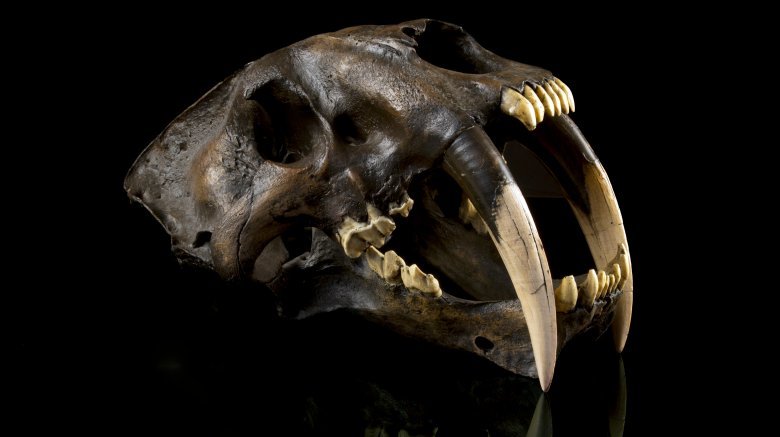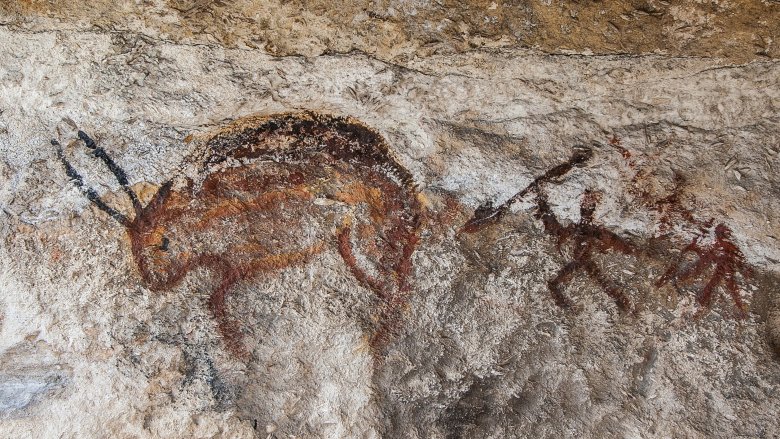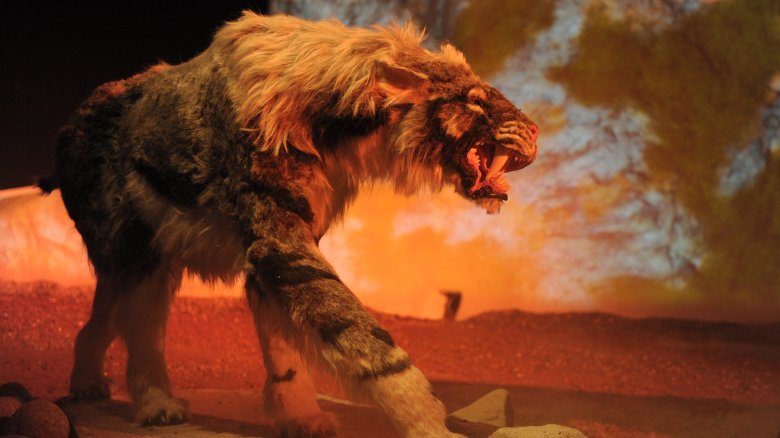The Reason Saber-Toothed Tigers Went Extinct
At first, it kind of seems like it would be pretty cool if saber-toothed tigers still roamed the American wilderness. But just imagine for a second if you had to worry about giant fanged cats while you were camping. Forget putting your food in a bear locker — you'd have to put your whole tent in one of those things. Yeah, saber-toothed tigers were cool, but their extinction pretty much made the whole camping and outdoor recreation industry possible.
Which brings us to the question: Why did they go extinct? It seems incredible to think that something as badass as a giant cat with teeth the size of your hand could ever be taken down by the forces of nature, but that's pretty much what happened.
Contrary to what people believed for a long time, though, saber-tooth tigers probably didn't die out because food was scarce. To make that determination, scientists looked at the fossilized teeth from 15 saber-toothed tigers and found that they lacked the kind of wear pattern you'd expect to see in an animal that isn't getting enough to eat. According to the Huffington Post, a starving cat would likely gnaw every kill it found down to the bone, so its teeth would show a micro-wear pattern similar to what you see in hyenas, which are efficient scavengers that typically consume every part of a carcass from hide to skeleton. So the big cats' extinction probably wasn't due to a scarcity of prey.
The decline of the world's megafauna
Okay, so we know what didn't kill them — but they did go extinct. So what gives? The researchers who authored the tooth-wear study didn't offer any alternative hypotheses, but later research by the Australian Centre for Ancient DNA suggested that it was a combination of a warming climate and human activity. Interestingly, humans and saber-toothed tigers co-existed for at least a thousand years, and it was only when the climate started to rapidly warm that populations of megafauna — oversized animals that include the saber-tooth tiger — began to decline. After that warming event, much of the world's megafauna were extinct within a century.
But why? It's impossible to say for sure. Studies have linked the decline of large herbivores like mammoths and woolly rhinos to human predation, but most also agree that it's difficult to know how much climate change might have contributed to that. According to The Atlantic, the decline of large mammals also might have had something like a snowball effect, since, whenever there's an extinction event, it tends to irreversibly alter the ecosystems where those animals live.
What we do know is that humans and our now-extinct cousins (species like Neanderthals and Denisovans) seemed to be rather suspiciously correlated with the decline of large mammals all over the world. As our ancestors and other human species migrated north to Europe and Asia, the average size of the land mammals they encountered dropped by roughly half. The same thing happened when humans got to Australia, only on a larger scale — Australian land mammals got about 10 times smaller. And in America, the average size of land mammals dropped from "mega" to "minuscule." Before human arrival, the average American land mammal weighed around 216 pounds. After early humans showed up and started waving their spears around, that dropped to an average of 17 pounds.
So what about the saber-tooth tiger's extinction?
It's easy to make the logical leap that the extinction of large herbivores would have left saber-tooth tigers with a fundamental problem. As the giant horses and camels and other megafauna it depended on for food started to die off, starvation became a very real threat. And yet, based on the aforementioned tooth evidence, we don't think that's what happened. If nothing else, it's an indication that the big cats were adaptable. Much like modern cats, when there isn't any Friskies in the bowl, well, the mice had better start watching their backs.
So maybe the decline of large prey forced the cats to turn to smaller prey, which would have included faster, four-footed animals, hard-to-catch birds, and humans. And as every cat knows, you don't waste your time chasing birds when you can attack someone's ankles instead. So maybe saber-tooth tigers started to view humans as their best source of alternate nourishment, and when that happened, maybe the humans were all, "Hey, it's really not cool to have these big cats attacking our ankles all the time." Which probably would have been incentive enough for them to start killing the big cats on sight.
Don't take that as more than speculation, though. Until someone invents a time machine, we're probably never going to know the final answer for sure.


